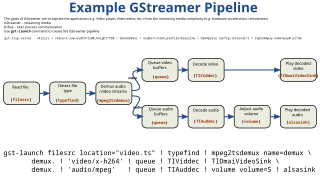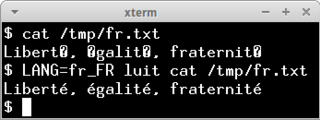NTLDR is the boot loader for all releases of Windows NT operating system up to and including Windows XP and Windows Server 2003. NTLDR is typically run from the primary hard disk drive, but it can also run from portable storage devices such as a CD-ROM, USB flash drive, or floppy disk. NTLDR can also load a non NT-based operating system given the appropriate boot sector in a file.
X.Org Server is the free and open-source implementation of the display server for the X Window System stewarded by the X.Org Foundation.

GStreamer is a pipeline-based multimedia framework that links together a wide variety of media processing systems to complete complex workflows. For instance, GStreamer can be used to build a system that reads files in one format, processes them, and exports them in another. The formats and processes can be changed in a plug and play fashion.
Mesa, also called Mesa3D and The Mesa 3D Graphics Library, is an open source software implementation of OpenGL, Vulkan, and other graphics API specifications. Mesa translates these specifications to vendor-specific graphics hardware drivers.

Xlib is an X Window System protocol client library written in the C programming language. It contains functions for interacting with an X server. These functions allow programmers to write programs without knowing the details of the protocol. Few applications use Xlib directly; rather, they employ other libraries that use Xlib functions to provide widget toolkits:
In computing, a file shortcut is a handle in a user interface that allows the user to find a file or resource located in a different directory or folder from the place where the shortcut is located. Similarly, an Internet shortcut allows the user to open a page, file or resource located at a remote Internet location or Web site.

NetworkManager is a daemon that sits on top of libudev and other Linux kernel interfaces and provides a high-level interface for the configuration of the network interfaces.
The X Window System core protocol is the base protocol of the X Window System, which is a networked windowing system for bitmap displays used to build graphical user interfaces on Unix, Unix-like, and other operating systems. The X Window System is based on a client–server model: a single server controls the input/output hardware, such as the screen, the keyboard, and the mouse; all application programs act as clients, interacting with the user and with the other clients via the server. This interaction is regulated by the X Window System core protocol. Other protocols related to the X Window System exist, both built at the top of the X Window System core protocol or as separate protocols.
In the X Window System, programs run as X clients, and as such they connect to the X display server, possibly via a computer network. Since the network may be accessible to other users, a method for forbidding access to programs run by users different from the one who is logged in is necessary.
In computing, a hidden folder or hidden file is a folder or file which filesystem utilities do not display by default when showing a directory listing. They are commonly used for storing user preferences or preserving the state of a utility, and are frequently created implicitly by using various utilities. They are not a security mechanism because access is not restricted - usually the intent is simply to not "clutter" the display of the contents of a directory listing with files the user did not directly create.
Linux color management has the same goal as the color management systems (CMS) for other operating systems: to achieve the best possible color reproduction throughout an imaging workflow from its source, through imaging software, and finally onto an output medium. In particular, color management attempts to enable color consistency across media and throughout a color-managed workflow.

nouveau is a free and open-source graphics device driver for Nvidia video cards and the Tegra family of SoCs written by independent software engineers, with minor help from Nvidia employees.

Xephyr is display server software implementing the X11 display server protocol based on KDrive which targets a window on a host X Server as its framebuffer. It is written by Matthew Allum. Xephyr is an X-on-X implementation and runs on X.Org Server and can work with Glamor. Future versions could make use of libinput. Replacing Xephyr with the xf86-video-dummy and xf86-video-nested drivers in the normal X.Org server is being considered as part of X11R7.8.
Readahead is a system call of the Linux kernel that loads a file's contents into the page cache. This prefetches the file so that when it is subsequently accessed, its contents are read from the main memory (RAM) rather than from a hard disk drive (HDD), resulting in much lower file access latencies.

Wayland is a computer protocol that specifies the communication between a display server and its clients, as well as a reference implementation of the protocol in the C programming language. A display server using the Wayland protocol is called a Wayland compositor.
In computing, SPICE is a remote-display system built for virtual environments which allows users to view a computing "desktop" environment – not only on its computer-server machine, but also from anywhere on the Internet – using a wide variety of machine architectures.
Dart is a general-purpose programming language originally developed by Google and later approved as a standard by Ecma (ECMA-408). It is used to build web, server, desktop, and mobile applications.

luit is a utility program used to translate the character set of a computer program so that its output can be displayed correctly on a terminal emulator that uses a different character set. Whereas iconv converts the character set of strings or text files at rest, luit converts the input and output of programs running interactively.
ASP.NET Web Forms is a web application framework and one of several programming models supported by the Microsoft ASP.NET technology. Web Forms applications can be written in any programming language which supports the Common Language Runtime, such as C# or Visual Basic. Main building blocks of Web Forms pages are server controls, which are reusable components responsible for rendering HTML markup and responding to events. A technique called view state is used to persist the state of server controls between normally stateless HTTP requests.








